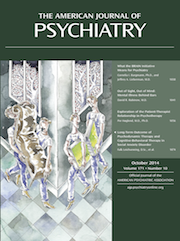The Risk of Switch to Mania in Patients With Bipolar Disorder During Treatment With an Antidepressant Alone and in Combination With a Mood Stabilizer
Abstract
Objective
This study examined the risk of antidepressant-induced manic switch in patients with bipolar disorder treated either with antidepressant monotherapy or with an antidepressant in conjunction with a mood stabilizer.
Method
Using Swedish national registries, the authors identified 3,240 patients with bipolar disorder who started treatment with an antidepressant and had no antidepressant treatment during the previous year. Patients were categorized into those receiving antidepressant monotherapy and those receiving an antidepressant plus a mood stabilizer. A within-individual design was used to control for confounding by disorder severity, genetic makeup, and early environmental factors. Cox regression analyses conditioned on individual were used to compare the rate of mania 0–3 months and 3–9 months after the start of antidepressant treatment with a preceding non-treatment period.
Results
Nearly 35% of the patients were treated with antidepressant monotherapy. The increased risk of treatment-emergent mania was confined to patients on antidepressant monotherapy (hazard ratio=2.83, 95% CI=1.12, 7.19). Among patients treated with a concurrent mood stabilizer, no acute change in risk of mania was observed during the 3 months after the start of antidepressant treatment (hazard ratio=0.79, 95% CI=0.54, 1.15), and a decreased risk was observed during the period 3–9 months after treatment initiation (hazard ratio=0.63, 95% CI=0.42, 0.93).
Conclusions
In this national registry study, antidepressant monotherapy was associated with an increased risk of mania. However, no risk of mania was seen in patients receiving an antidepressant while treated with a mood stabilizer. The results highlight the importance of avoiding antidepressant monotherapy in the treatment of bipolar disorder.



